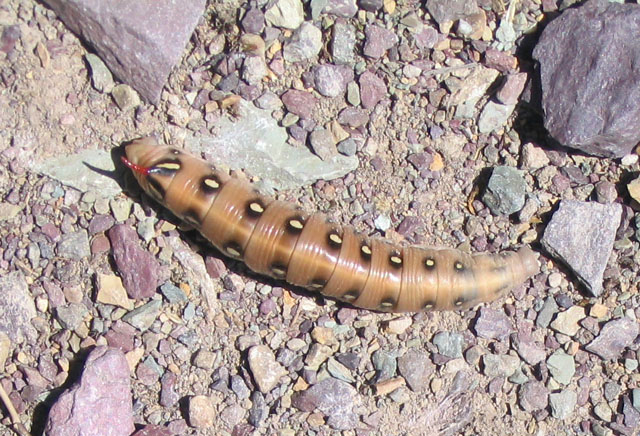Glacier County, Montana
Sphingidae

|
|
Inspired/dedicated as per personal communication with George Rogers (Hyles lineata), August 30, 2005 Updated as per James P. Tuttle's The Hawk Moths of North America, August 2, 2011 Updated as per BAMONA, August 2, 2011 |

This page is inspired by and dedicated to George Rogers who sent me the image of Hyles lineata at the top of the page. George writes, "The caterpillar was on a dirt hiking trail leading up to Gunsight Pass from Lake Ellen Wilson. Altitude was about 6500, and the terrain was dirt and rock with flowers, bushes, and lots of wildflowers - no trees. Lots of water in the area due to snow runoff, but he was on dry dirt. Seemed to be unhappy, and moving quickly but often rolling over. Did not seem to be injured. About three inches in length."
Hyles lineata usually have a green ground colour, but this one has changed as it is ready to pupate. The stumpy legs, associated with this stage of development, are probably responsible for the "rolling over" observed by George.
It is hoped that this checklist, with the thumbnails and notes, will help you quickly identify the moths you have encountered.
A "WO" after the species name indicates that I have no confirmed reports of this species in Glacier County, but I (William Oehlke) expect that this moth is present or might be present. A USGS indicates the moth is reported on the USGS website and/or in Moths of Western North America, #2. Distribution of Sphingidae of Western North America, revised, an excellent little booklet available through Paul Opler.
Please help me develop this list with improved, documented accuracy by sending sightings (species, date, location), preferably with an image, via email to Bill Oehlke.
Sphinginae subfamily
Smerinthini Tribe:
Macroglossinae subfamilyDilophonotini tribe
Macroglossini tribe
|
Enjoy some of nature's wonderments, giant silk moth cocoons. These cocoons are for sale winter and fall. Beautiful Saturniidae moths will emerge the following spring and summer. Read Actias luna rearing article. Additional online help available.
Eggs of many North American species are offered during the spring and summer. Occasionally summer Actias luna and summer Antheraea polyphemus cocoons are available. Shipping to US destinations is done from with in the US.
Use your browser "Back" button to return to the previous page.
This page is brought to you by Bill Oehlke and the WLSS. Pages are on space rented from Bizland. If you would like to become a "Patron of the Sphingidae Site", contact Bill.
Please send sightings/images to Bill. I will do my best to respond to requests for identification help.
 Show appreciation for this site by clicking on flashing butterfly to the left. The link will take you to a page with links to many insect sites. |
I very much appreciate all the many images that have been sent to me, or of which I have been granted permission to copy and post from other websites. All images on this site remain the property of respective photographers.
If you would like to contribute to the maintenace of this website by sending a contribution to
Bill Oehlke
Box 476
155 Peardon Road
Montague, Prince Edward Island, C0A1R0
Canada
your donation would be much appreciated and would be used for
1) paying for webspace rental;
2) paying for computer maintenance and software upgrades;
3) purchases of additional text reference material (journals and books) in anticipation of expanding the site to a worldwide Sphingidae site;
4) helping to pay my daughter's tuition (completed spring 2013); with anything left over going to humanitarian aid.
If you are mailing a check from USA, please use $1.15 postage. Donations can also be made through Paypal via the button below.